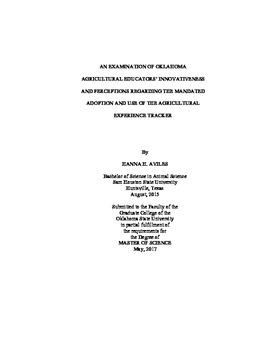| dc.description.abstract | Record keeping has been long regarded as an essential skill related to the success of students' supervised agricultural experience (SAE) programs. Following the integration of computers in school-based agricultural education (SBAE), several electronic, record keeping mediums entered the marketplace. Despite its increasing prominence, The Agricultural Experience Tracker (the AET) has been narrowly researched, and no literature regarding its diffusion or adoption presently exists. As such, this study served to address this paucity of literature by examining this phenomenon through the lens of Rogers' (2003) diffusion of innovations theory. The two-fold purpose of this study was to 1) describe the relationships between the innovativeness of SBAE programs in Oklahoma and the perceptions of SBAE teachers regarding diffusion of the AET; 2) predict the innovativeness of SBAE programs in Oklahoma from SBAE teachers' selected personal and professional characteristics and perceptions regarding diffusion of the AET. This study was descriptive, predictive, and correlational in nature, and employed a cross-sectional, survey design. Prior to data collection and in accord with Rogers' (2003) conventions, every SBAE program in Oklahoma was categorized by innovativeness regarding adoption and use of the AET. From the findings, it was concluded that the SBAE programs with older and/or more experienced teachers were more innovative than those with younger and/or less experienced teachers. Collectively, SBAE teachers in Oklahoma considered the AET to be complex. However, in addition to perceiving the AET as being less relatively advantageous and compatible, the SBAE teachers with more years of experience considered the AET to be less complex than those with fewer years of experience. Time-related concerns were identified as a strong barrier to SBAE teachers' adoption and use of the AET. Finally, using hierarchical, block regression analysis, a predictive model for SBAE program innovativeness was developed, with the third model explaining a total of 26% of the variance in SBAE program innovativeness. Targeted, in-service training opportunities are recommended in the areas of use and navigation of the AET, financial accounting, and time management. Further investigation of the AET's diffusion is recommended in other states, as well as in both mandated and voluntary use contexts. | |
